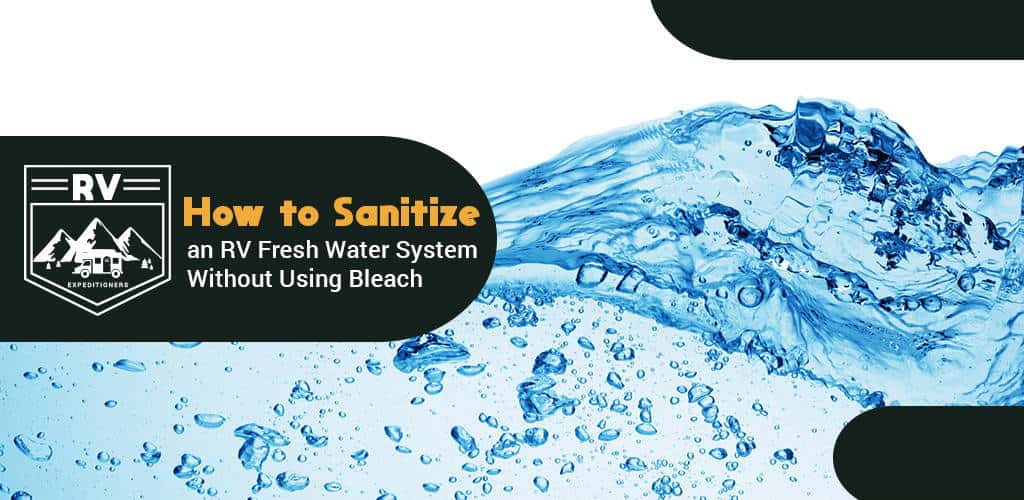A critical component of enjoying every RV adventure is keeping your fresh water system clean. Regular sanitizing is an essential part of regular water system maintenance, and you want to ensure that no microbial or chemical residue builds up in the tank. Bleach is considered the most thorough and effective cleaning agent for sanitizing water systems, but it also generates a significant health risk from fumes and contamination if the system isn’t flushed out thoroughly. There’s also a risk that the tank itself will retain bleach even with thorough flushing.
What should you do? Your safety and the safety of your family is at stake. This isn’t something you can just play by ear: you need to follow a safe, step-by-step process that will thoroughly clean and sanitize your fresh water tank. Fortunately, there are several methods you can use to accomplish this task without using bleach. Here are the four most effective ways to sanitize your RV fresh water tank without using bleach or other harsh chemicals.
Vinegar
Readily available and easier to work with than bleach or other detergents, vinegar is the first choice for efficient and effective sanitization.
1. What You Will Need
- Plenty of white vinegar
- a clean water supply
- several gallon jugs or five gallon bucket
- a large funnel
2 . Step by Step Guide
- Mix up a 1:1 solution of vinegar to water in your gallon jugs or five gallon bucket.
- Add your mixture to the fresh water tank using the large funnel. Fill the tank with the vinegar solution to about half capacity.
- Take your RV for a casual drive that involves plenty of turning. This helps spread the vinegar solution around and clean as much of the tank as possible.
- Open the windows on your RV (a critical step) and turn on all the water fixtures including everything in your bathroom.
- Run your water until you start to smell vinegar, then shut the taps off to hold the vinegar solution in the RV water lines.
- Take a break for three to four hours and allow the acetic acid in the vinegar to kill any lingering bacteria and break up any minerals in the water system.
- Open the windows again if you’ve closed them, then turn on the taps to let the vinegar solution run clear of your water system.
- Refill the tank half-way with fresh water from a water source, then run it through the system to purge the lines and tank of the vinegar solution.
- Take another break because your work is done.
3. Tips and Warnings
For best results, always use clean municipal or city water to sanitize and flush your water tank.
If you don’t live the RV life full time, drain and flush your fresh water tank before storing your RV for the season.
If your RV is your primary residence, be sure to sanitize and flush your clean water tank at least twice per year.
4. Conclusion
Vinegar is an excellent cleaning agent because it kills bacteria and breaks down mineral deposits found in water supplies. If you want to use an all natural cleaning method that won’t damage your plumbing or fill your tank and water lines with harsh chemicals, vinegar is the way to go.
By Baking Soda:
Another readily accessible fresh water system cleaning solution, baking soda will not damage your plumbing and doesn’t leave a lingering aftertaste in the water or a strong odor.
1. What You Will Need
- Baking soda
- Water
2. Step by Step Guide
Mix up a solution of 3.8 liters of water and 240 grams of baking soda. Use a funnel to add this solution to your fresh water tank.
Fill your fresh water tank all the way up from a clean water source, preferably from a municipal water supply.
Take your RV for a 10-15 minute drive with a good number of turns to slosh the mixture around inside the tank..
Turn on all the taps and shower heads in your RV to flush the system. You don’t need to let the solution sit in the water lines for this sanitization method like you do with vinegar.
Fill up the clean water tank from a clean water source again..
Turn on all the taps again and let the water run clear.
Enjoy your freshly sanitized clean water tank.
3. Tips and Warnings
As with the vinegar sanitization method, only use clean municipal water. City water is far less likely to contain bacterial or mineral contaminants than water sources in remote locations.
Always flush your clean water system before putting your RV in storage.
Sanitize your clean water tank twice a year if your RV is your primary residence.
4. Conclusion
Many RV owners prefer the baking soda method to the vinegar method because there is no risk of an aftertaste once sanitization is complete. Moreover, there is no wait time while the vinegar sanitizes the lines. If you live in your RV full time and need to sanitize your clean water system as expediently as possible, the baking soda method is going to be your best bet since it doesn’t tie up the water system for half a day like the vinegar method.

